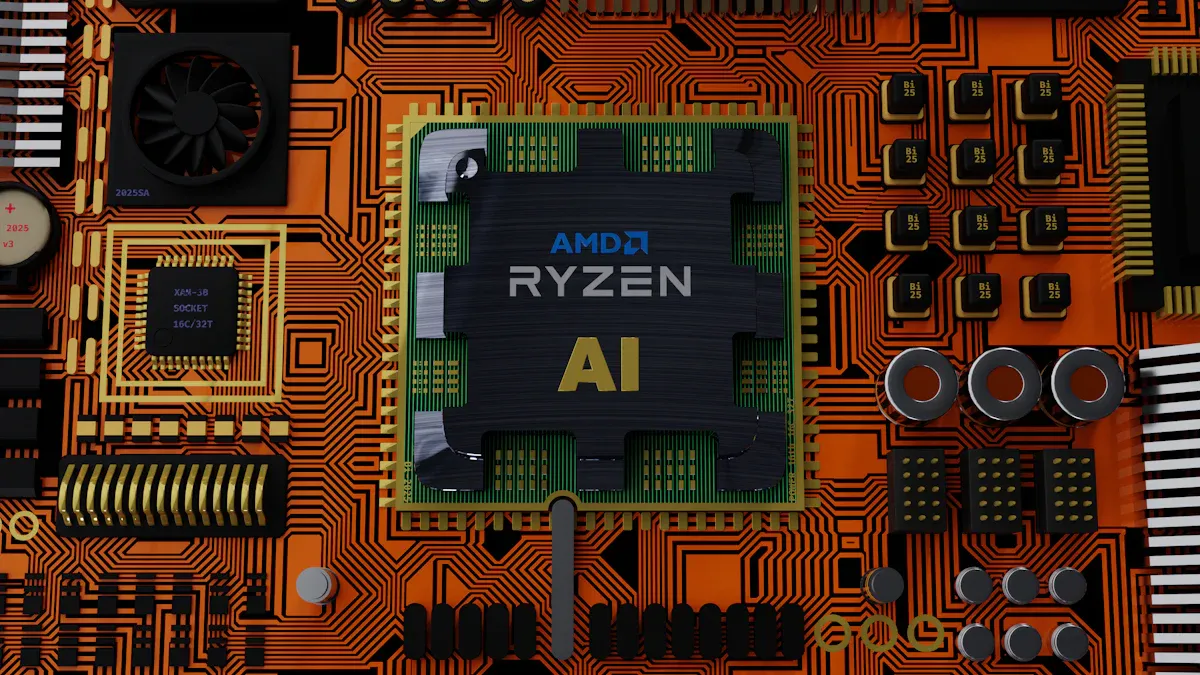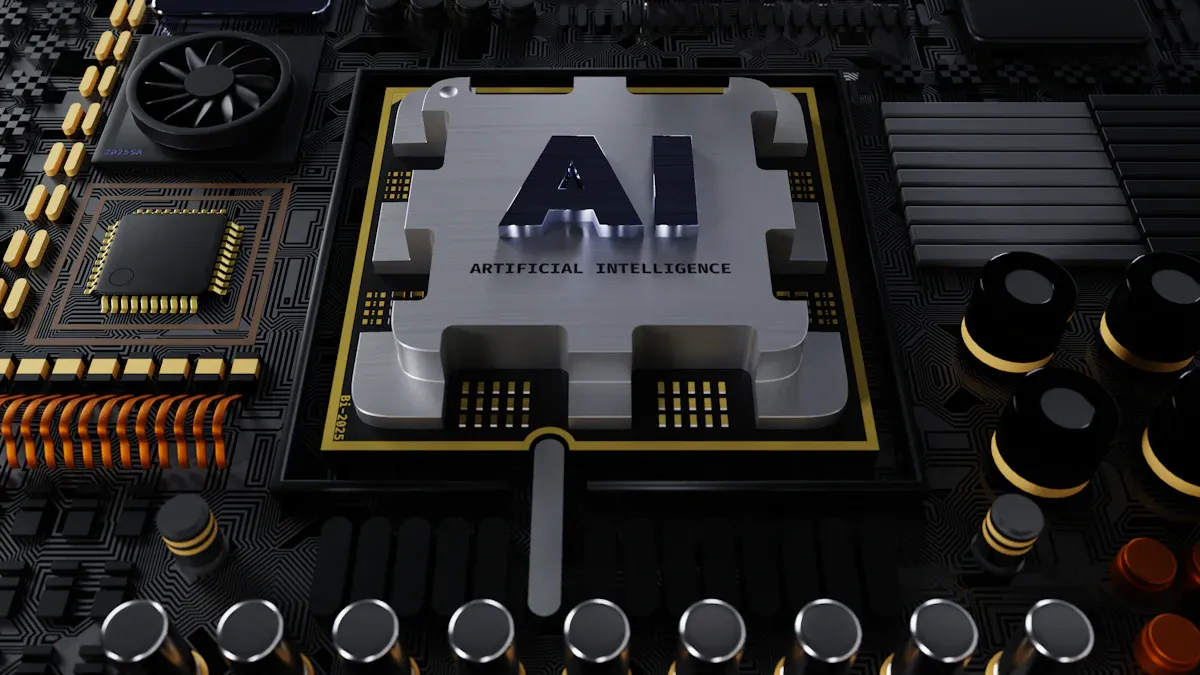What Are AI Chips and How Do They Power Modern Technology

AI chips are special computer chips designed to help machines learn, reason, and make decisions quickly. You see their power in voice assistants, self-driving cars, and even smart home gadgets. Unlike regular chips, AI chips can handle many tasks at once and use less energy. This makes them perfect for running advanced artificial intelligence. The worldwide market for these chips is growing fast, reaching over $23 billion in 2023 and set to multiply in the coming years.
Key Takeaways
AI chips are special computer chips that help devices learn and make decisions faster while using less energy.
These chips process many tasks at once using parallel processing, making devices like smartphones and self-driving cars smarter and quicker.
Different types of AI chips, such as GPUs, ASICs, FPGAs, and NPUs, serve unique roles from training AI models to running AI on mobile devices.
AI chips improve everyday technology by enhancing photos, voice assistants, and real-time translations, while also powering data centers and autonomous vehicles.
The future of AI chips looks bright with ongoing innovations that promise faster, more efficient, and smarter technology in many industries.
AI Chips Explained

Definition
AI chips are special computer chips built to handle the heavy work of artificial intelligence. You can think of them as tiny brains inside your devices. These chips use billions of small, fast transistors that switch on and off quickly. This design lets them process huge amounts of data in seconds. AI chips work much faster and use less energy than regular computer chips. They use smart designs and advanced materials to make sure they can keep up with the demands of modern technology.
Core Function
You use AI chips when you want your devices to learn, recognize images, or understand speech. Their main job is to process lots of information at once. Here are some key things that set their function apart:
They handle complex AI tasks like image recognition and natural language processing.
They use parallel processing, which means they can do many calculations at the same time.
They use smaller and more efficient transistors, so they work faster and save energy.
Some types, like ASICs and FPGAs, can be customized for special jobs.
They give you more accurate results in tasks that need speed and precision, such as medical imaging or self-driving cars.
Tip: When you use a voice assistant or play a video game with smart graphics, you are likely using a device powered by AI chips.
Key Differences
AI chips stand out from traditional CPUs in several important ways. You can see these differences in how they are built and how they work:
Transistor Size and Speed: AI chips use a larger number of smaller, faster transistors. This means they can do more work with less energy.
Parallel Processing: Unlike CPUs, which often handle one task at a time, AI chips can process many tasks at once. This makes them much faster for AI workloads.
Energy Efficiency: AI chips use less power because they distribute tasks efficiently and use techniques like low-precision arithmetic.
Custom Design: Some AI chips can be programmed for specific jobs, giving you better performance for certain tasks.
Advanced Materials: AI chips use special materials to make transistors even smaller and more reliable. Here is a table showing some of these materials and their benefits:
Material | Usage in AI Chip Manufacturing | Benefits Provided |
|---|---|---|
Aluminum chloride | Used in 3D NAND memory manufacturing | Safer handling, precise thin film deposition, supports very small transistor nodes |
Hafnium chloride | Used for high-k dielectrics in logic chips | Improves transistor performance, helps make chips smaller |
Molybdenum dichloride dioxide | Used in advanced AI devices | Low fluorine, good resistivity, supports complex chip structures |
Tantalum | Used as a diffusion barrier in copper wiring | Prevents copper spread, improves stability, resists corrosion |
You benefit from these differences every time you use a device that needs to think fast and use less battery. AI chips help your technology run smarter and more efficiently.
Architecture and Efficiency
Parallel Processing
AI chips use parallel processing to make your devices much faster and smarter. Instead of doing one thing at a time, these chips can handle many tasks all at once. You benefit from this design every time you use a device that needs to think quickly, like a phone or a smart speaker.
AI chips have many small cores that work together, unlike regular chips that process tasks one by one.
Neural networks need lots of simple math done at the same time. AI chips do this very well.
With parallel processing, AI chips can train and run AI models much faster.
These chips have higher memory bandwidth, which means they move data quickly to keep up with all the tasks.
You get up to 10 times faster performance in AI tasks compared to older chips.
Note: Parallel processing helps your devices respond quickly, whether you are asking a question or playing a game.
Low-Precision Arithmetic
AI chips also use low-precision arithmetic to boost speed and save energy. Instead of using long numbers, they use shorter ones, like FP16 or INT8. This change lets the chip fit more math units in the same space and use less power for each calculation. You still get accurate results because AI models can handle a little bit of noise or error. For example, training with FP8 numbers can make learning up to 50% faster without losing quality. When you use a device with AI, low-precision arithmetic helps it run longer on a battery and work well even if it is not very powerful. Special hardware designs, like IBM’s Spyre accelerator, make the most of these benefits.
Materials
The materials inside AI chips play a big role in how well they work and how much they cost. Silicon is the main material for most chips. It is cheap and easy to use, which keeps prices low. Gallium nitride (GaN) is another important material. It gives chips better speed, stronger signals, and uses less energy, especially in wireless devices. In the past, adding GaN to chips cost a lot and was hard to do. Now, new ways to connect GaN to silicon make it easier and cheaper. This mix gives you the best of both worlds: the low cost of silicon and the high performance of GaN. Your devices get better battery life, stronger connections, and stay cooler, all thanks to these advanced materials.
Types of AI Chips

When you explore the world of ai chips, you find several main types. Each type has a unique design and purpose. Here is a quick overview:
AI Chip Type | Architecture & Design | Key Features & Differences |
|---|---|---|
GPU (Graphics Processing Unit) | Parallel processing units originally for graphics rendering | Excels at parallel processing, ideal for training AI models, handles thousands of simultaneous operations |
FPGA (Field-Programmable Gate Array) | Reconfigurable and programmable after manufacturing | Flexible, customizable for specialized AI workloads, lower latency and energy efficient, suited for edge and real-time applications |
ASIC (Application-Specific Integrated Circuit) | Custom-designed for specific AI tasks | Maximum performance and energy efficiency, optimized for dedicated functions like inference, e.g., Google's TPU |
NPU (Neural Processing Unit) | Dedicated AI accelerators optimized for neural network operations | Optimized for matrix multiplication and convolution, commonly used in mobile and edge devices for on-device AI processing |
GPUs
GPUs help you train and run AI models quickly. They use parallel processing, which means they can handle many calculations at once. You see GPUs in tasks like image recognition, natural language processing, and even creating new images or videos. Industries such as healthcare, retail, and entertainment use GPUs for faster results. Programming tools like CUDA and frameworks like TensorFlow make it easier for you to use GPUs for ai chips.
GPUs shine when you need to process lots of data at the same time, such as in computer vision or chatbots.
TPUs
TPUs, or Tensor Processing Units, are special chips made by Google. They focus on tensor operations, which are key for deep learning. TPUs train models like BERT and ResNet much faster than GPUs and use less energy. You often find TPUs in Google’s cloud services. They work best with TensorFlow and help you save time and power when training large AI models.
ASICs
ASICs are custom-built for specific AI tasks. You get the highest performance and energy savings with these chips. ASICs work well in places where you need fast, real-time results, such as self-driving cars or security cameras. They do not waste power on extra features, so they run cool and efficiently. ASICs are perfect for mature and high-volume AI applications.
FPGAs
FPGAs let you reprogram the chip for different AI tasks. You can customize them for jobs like image processing or speech recognition. FPGAs use less power and give you quick responses, which is important for real-time AI. They work well in edge devices and can handle thousands of inferences per second. You also get better security because FPGAs can process data locally.
NPUs
NPUs, or Neural Processing Units, are designed for AI tasks in edge devices. You find them in smartphones, smart cameras, and wearables. NPUs process neural networks directly on the device, which means you get fast results and better privacy. They use less power than GPUs or TPUs, making them great for mobile and small devices. NPUs help your devices run AI features smoothly without needing the cloud.
AI Chips in Technology
Consumer Devices
You use ai chips every day, often without noticing. Modern smartphones, like the HONOR Magic6 Pro, use these chips to improve your photos with features such as AI Motion Sensing Capture. Smart TVs, like those powered by MediaTek’s Pentonic 2000 chip, offer sharper images and better sound by using AI to recognize scenes and objects. AI chips also help your phone’s voice assistant answer questions faster and more accurately. They power real-time language translation, making it easier for you to talk with people from different countries. Many devices use ai chips to suggest content you might like or to run augmented reality apps smoothly.
AI chips make your devices smarter, faster, and more personal.
Data Centers
Data centers use ai chips to handle huge amounts of information quickly and efficiently. These chips help companies process data for search engines, social media, and cloud services. New materials like gallium nitride and silicon carbide allow data centers to use less energy and stay cool, even as they work harder. Custom AI chips, such as ASICs, make it cheaper and faster to run complex AI programs. With these improvements, data centers can grow and support more users without slowing down.
Autonomous Vehicles
Self-driving cars rely on ai chips to see and understand the world around them. These chips process data from cameras, radar, and other sensors in real time. For example, NVIDIA’s Drive platform uses ai chips to help cars recognize objects, predict hazards, and make safe driving decisions in milliseconds. AI chips also help electric vehicles save battery power by handling tasks more efficiently. As a result, you get safer rides and smarter cars.
Healthcare
In healthcare, ai chips help doctors and nurses diagnose and treat patients faster. They analyze medical images, such as X-rays and MRIs, to spot problems like tumors or strokes. AI chips can find patterns that even experts might miss, leading to more accurate results. Hospitals use these chips to speed up urgent cases and reduce errors in reports. Wearable devices also use ai chips to monitor your health in real time, giving you and your doctor better information.
Robotics
Robots in factories and hospitals use ai chips to work smarter and safer. In manufacturing, robots weld, assemble, and check products for quality. Collaborative robots, or cobots, work alongside people to boost productivity. In hospitals, robots deliver medicine and help with surgeries. Service robots in hotels and stores greet customers and manage inventory. AI chips let these robots see, understand, and learn from their surroundings, making them more helpful in many jobs.
Benefits and Future
Performance
You can measure the power of AI chips in many ways. When you look at performance, you often see terms like teraflops and TOPS. These numbers show how many calculations a chip can do each second. Teraflops focus on floating-point math, which is important for training AI models. TOPS measure how fast a chip can handle tasks like image recognition.
Teraflops show peak speed for training big AI models.
TOPS help you understand how well a chip runs real-time AI tasks.
Power efficiency and memory bandwidth matter as much as raw speed.
New benchmarks, like MLCommons MLPerf, test chips on real-world jobs such as answering questions or generating code.
You also need to look at how flexible a chip is for different uses, from phones to data centers.
Note: Fast chips are great, but you also want them to use less energy and work well in many places.
Challenges
AI chip makers face big hurdles today. Power use keeps rising as AI models get bigger. Memory can’t always keep up with the huge amounts of data. Connecting many chips together is hard and can slow things down. Software is another problem. Outside of Nvidia’s CUDA, many platforms are not stable or easy to use.
Challenge Area | Description and Impact |
|---|---|
Power Consumption | AI chips need more electricity as models grow. This could use up to 16% of U.S. power by 2030. Companies must find ways to save energy. |
Memory Bandwidth | AI models grow fast, but memory does not. This creates slowdowns and bottlenecks. |
Interconnect Limitations | Chips need better ways to talk to each other. Old methods can’t keep up with new demands. |
Software Ecosystem | Many chips lack strong software support, making them hard to use outside big brands. |
Supply Chain | Rare materials and global events can delay chip production and raise costs. |
Trends
You will see many new trends shaping AI chips. Companies use AI and machine learning to design better chips faster. Tools like reinforcement learning help create smarter layouts and speed up testing. More chips now use 3D stacking and combine different types of processors for better results. Neuromorphic chips, which work like the human brain, promise big energy savings. Quantum computing could one day solve problems much faster than today’s chips.
The AI chip market is set to grow quickly, reaching over $800 billion by 2035.
More industries, like healthcare and finance, use AI chips to boost speed and accuracy.
Edge computing brings AI chips to your phone, car, and home, making devices smarter and more private.
Companies invest in new ways to make chips, like using AI for design and testing.
You will see more chips built for special jobs, like self-driving cars or smart cameras.
AI chips will keep changing how you live, work, and play. The future looks bright for smarter, faster, and more efficient technology.
You see ai chips driving a new era in technology.
These chips deliver faster speeds, lower energy use, and real-time results for tasks like deep learning and image recognition.
Companies such as NVIDIA, AMD, and Intel keep pushing innovation with advanced designs and new materials.
Recent breakthroughs, shown in the table below, help industries from healthcare to automotive grow smarter and more efficient.
Company | Recent AI Chip Innovations |
|---|---|
NVIDIA | |
AMD | Instinct MI300 series, Ryzen AI 300 Pro |
Intel | Gaudi 3 AI accelerators, Core Ultra Processors |
As ai chips continue to evolve, you will notice their impact in daily life and across every industry.
FAQ
What makes AI chips different from regular computer chips?
AI chips process many tasks at the same time. You get faster results and use less energy. Regular chips handle one job at a time. AI chips use special designs and materials to work better for artificial intelligence.
Can you find AI chips in everyday devices?
Yes, you can. Your smartphone, smart speaker, and even some TVs use AI chips. These chips help your devices recognize voices, improve photos, and suggest content you might like.
Do AI chips help save battery life?
AI chips use less power because they work more efficiently. You get longer battery life in your phone or wearable device. This means you can use your device for more hours without charging.
Are AI chips only for big companies?
No, you can find AI chips in many products for home and school. Small businesses and students use devices with AI chips every day. You do not need to be a big company to benefit from this technology.
See Also
Understanding Computer Chips And Their Functionality Explained
A Comprehensive Guide To Communication Chips And Operations
Industrial Control Chips And Their Role In Automation Systems
Latest Developments In Automotive-Grade Chip Technology Trends
